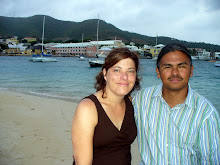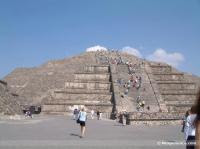 Many of the buildings here are covered with tiles – it’s a beautiful effect. Many also have elaborate white molding, and it reminds me of the piping along a wedding cake. The building above is the Casa de los Munecos (House of Dolls). Some tiled panels show figures.
Many of the buildings here are covered with tiles – it’s a beautiful effect. Many also have elaborate white molding, and it reminds me of the piping along a wedding cake. The building above is the Casa de los Munecos (House of Dolls). Some tiled panels show figures.Since we are only in Puebla for one full day, we crammed a lot into Sunday. We took a walking tour of the city center, and stopped along several museums along the way. At the Museo Jose Luis Bello, we received a guided tour of a 19th century collectors home and art.
 Our next stop was the Iglesia de Santa Rosa, and the museum now housed in its ex-convent. The museum was quite interesting; unfortunately I couldn’t take pictures inside. Once again we received a guided tour, which was very informative. The museum contained arts and handicrafts from each of Puebla’s seven regions. We also saw part of the convent, including a bedroom. Girls arrived at this convent between ages 12 and 14, took a vow of poverty and silence, and never left. My girls were amazed! Most exciting in this museum was the convents large and beautifully tiled kitchen.
Our next stop was the Iglesia de Santa Rosa, and the museum now housed in its ex-convent. The museum was quite interesting; unfortunately I couldn’t take pictures inside. Once again we received a guided tour, which was very informative. The museum contained arts and handicrafts from each of Puebla’s seven regions. We also saw part of the convent, including a bedroom. Girls arrived at this convent between ages 12 and 14, took a vow of poverty and silence, and never left. My girls were amazed! Most exciting in this museum was the convents large and beautifully tiled kitchen. As we exited the museum, we saw the patio of the ex-convent was set up for a concert. We watched the orchestra for a about 20 minutes, and then were ready to move on.
As we exited the museum, we saw the patio of the ex-convent was set up for a concert. We watched the orchestra for a about 20 minutes, and then were ready to move on. We walked up a street filled with candy shops, and bought a few pieces of candy for after lunch. Our final museum of the day was the Museo Regional de la Revolucion Mexicana (Regional Museum of the Mexican Revolution). This was the home of the Serdan family and they were attacked two days before the planned uprising against Mexico’s dictator-president Porfirio Diaz in November of 1910. Notice the bullet marks on the exterior of the house. The house contains artifacts and information about the revolution as well as the family that lived here.
We walked up a street filled with candy shops, and bought a few pieces of candy for after lunch. Our final museum of the day was the Museo Regional de la Revolucion Mexicana (Regional Museum of the Mexican Revolution). This was the home of the Serdan family and they were attacked two days before the planned uprising against Mexico’s dictator-president Porfirio Diaz in November of 1910. Notice the bullet marks on the exterior of the house. The house contains artifacts and information about the revolution as well as the family that lived here. By now we were ready for lunch, so we walked to the zocalo and had lunch. I had chilaquiles, which I’ve seen on the menu for weeks, but never had. They are chip-shaped tortillas (not fried), covered in sauce (I had red sauce), with just a little cheese, chicken and avocado slices on them. Very tasty.
 In the afternoon we drove over to a park a few miles from the city center. It contains a planetarium, some wide open spaces, a playground and a Mexican fort. We checked out the fort, which was the site of the Battle of Puebla on May 5, 1862 (Cinco de Mayo). A small Mexican army defeated a much larger and better equipped French army on this day. The French eventually occupied Mexico and Benito Juarez’s government went into exile until being reinstated in1867, after the U.S. helped Mexico kick out the French.
In the afternoon we drove over to a park a few miles from the city center. It contains a planetarium, some wide open spaces, a playground and a Mexican fort. We checked out the fort, which was the site of the Battle of Puebla on May 5, 1862 (Cinco de Mayo). A small Mexican army defeated a much larger and better equipped French army on this day. The French eventually occupied Mexico and Benito Juarez’s government went into exile until being reinstated in1867, after the U.S. helped Mexico kick out the French.
 In the afternoon we drove over to a park a few miles from the city center. It contains a planetarium, some wide open spaces, a playground and a Mexican fort. We checked out the fort, which was the site of the Battle of Puebla on May 5, 1862 (Cinco de Mayo). A small Mexican army defeated a much larger and better equipped French army on this day. The French eventually occupied Mexico and Benito Juarez’s government went into exile until being reinstated in1867, after the U.S. helped Mexico kick out the French.
In the afternoon we drove over to a park a few miles from the city center. It contains a planetarium, some wide open spaces, a playground and a Mexican fort. We checked out the fort, which was the site of the Battle of Puebla on May 5, 1862 (Cinco de Mayo). A small Mexican army defeated a much larger and better equipped French army on this day. The French eventually occupied Mexico and Benito Juarez’s government went into exile until being reinstated in1867, after the U.S. helped Mexico kick out the French. 






No comments:
Post a Comment